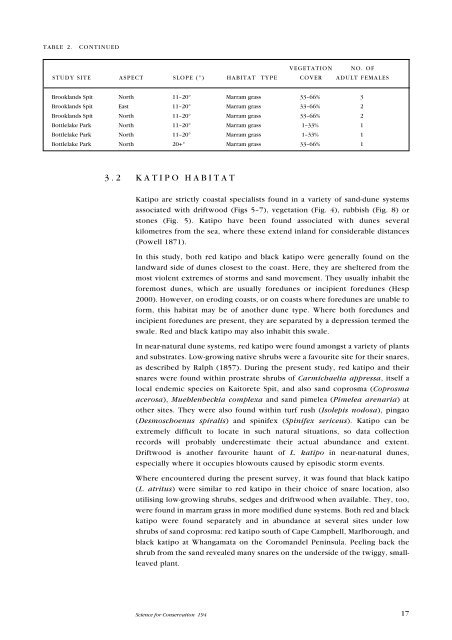Conservation status of the New Zealand red katipo spider ...
Conservation status of the New Zealand red katipo spider ...
Conservation status of the New Zealand red katipo spider ...
You also want an ePaper? Increase the reach of your titles
YUMPU automatically turns print PDFs into web optimized ePapers that Google loves.
TABLE 2. CONTINUED<br />
VEGETATION NO. OF<br />
STUDY SITE ASPECT SLOPE (°) HABITAT TYPE COVER ADULT FEMALES<br />
Brooklands Spit North 11–20° Marram grass 33–66% 3<br />
Brooklands Spit East 11–20° Marram grass 33–66% 2<br />
Brooklands Spit North 11–20° Marram grass 33–66% 2<br />
Bottlelake Park North 11–20° Marram grass 1–33% 1<br />
Bottlelake Park North 11–20° Marram grass 1–33% 1<br />
Bottlelake Park North 20+° Marram grass 33–66% 1<br />
3.2 KATIPO HABITAT<br />
Katipo are strictly coastal specialists found in a variety <strong>of</strong> sand-dune systems<br />
associated with driftwood (Figs 5–7), vegetation (Fig. 4), rubbish (Fig. 8) or<br />
stones (Fig. 5). Katipo have been found associated with dunes several<br />
kilometres from <strong>the</strong> sea, where <strong>the</strong>se extend inland for considerable distances<br />
(Powell 1871).<br />
In this study, both <strong>red</strong> <strong>katipo</strong> and black <strong>katipo</strong> were generally found on <strong>the</strong><br />
landward side <strong>of</strong> dunes closest to <strong>the</strong> coast. Here, <strong>the</strong>y are shelte<strong>red</strong> from <strong>the</strong><br />
most violent extremes <strong>of</strong> storms and sand movement. They usually inhabit <strong>the</strong><br />
foremost dunes, which are usually fo<strong>red</strong>unes or incipient fo<strong>red</strong>unes (Hesp<br />
2000). However, on eroding coasts, or on coasts where fo<strong>red</strong>unes are unable to<br />
form, this habitat may be <strong>of</strong> ano<strong>the</strong>r dune type. Where both fo<strong>red</strong>unes and<br />
incipient fo<strong>red</strong>unes are present, <strong>the</strong>y are separated by a depression termed <strong>the</strong><br />
swale. Red and black <strong>katipo</strong> may also inhabit this swale.<br />
In near-natural dune systems, <strong>red</strong> <strong>katipo</strong> were found amongst a variety <strong>of</strong> plants<br />
and substrates. Low-growing native shrubs were a favourite site for <strong>the</strong>ir snares,<br />
as described by Ralph (1857). During <strong>the</strong> present study, <strong>red</strong> <strong>katipo</strong> and <strong>the</strong>ir<br />
snares were found within prostrate shrubs <strong>of</strong> Carmichaelia appressa, itself a<br />
local endemic species on Kaitorete Spit, and also sand coprosma (Coprosma<br />
acerosa), Muehlenbeckia complexa and sand pimelea (Pimelea arenaria) at<br />
o<strong>the</strong>r sites. They were also found within turf rush (Isolepis nodosa), pingao<br />
(Desmoschoenus spiralis) and spinifex (Spinifex sericeus). Katipo can be<br />
extremely difficult to locate in such natural situations, so data collection<br />
records will probably underestimate <strong>the</strong>ir actual abundance and extent.<br />
Driftwood is ano<strong>the</strong>r favourite haunt <strong>of</strong> L. <strong>katipo</strong> in near-natural dunes,<br />
especially where it occupies blowouts caused by episodic storm events.<br />
Where encounte<strong>red</strong> during <strong>the</strong> present survey, it was found that black <strong>katipo</strong><br />
(L. atritus) were similar to <strong>red</strong> <strong>katipo</strong> in <strong>the</strong>ir choice <strong>of</strong> snare location, also<br />
utilising low-growing shrubs, sedges and driftwood when available. They, too,<br />
were found in marram grass in more modified dune systems. Both <strong>red</strong> and black<br />
<strong>katipo</strong> were found separately and in abundance at several sites under low<br />
shrubs <strong>of</strong> sand coprosma: <strong>red</strong> <strong>katipo</strong> south <strong>of</strong> Cape Campbell, Marlborough, and<br />
black <strong>katipo</strong> at Whangamata on <strong>the</strong> Coromandel Peninsula. Peeling back <strong>the</strong><br />
shrub from <strong>the</strong> sand revealed many snares on <strong>the</strong> underside <strong>of</strong> <strong>the</strong> twiggy, smallleaved<br />
plant.<br />
Science for <strong>Conservation</strong> 194<br />
17

















